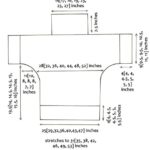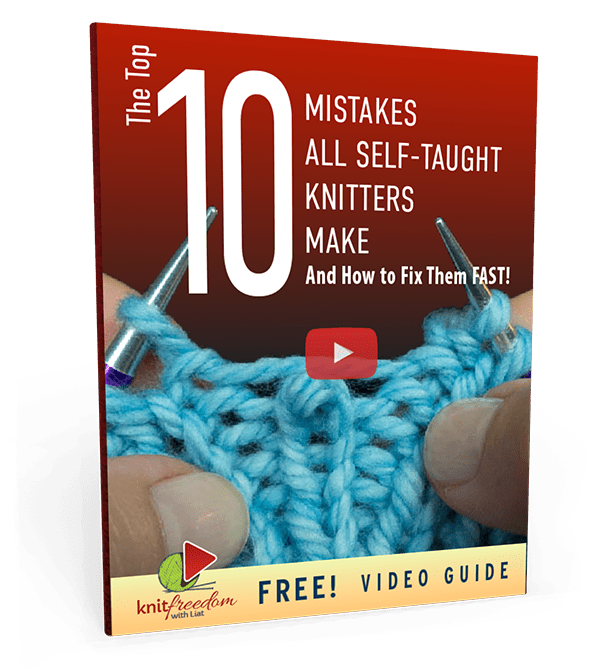Ch. 1 Reading a Knitting Pattern
Learning to read patterns is the key to breaking out of beginner knitting and getting on the road to knitting with confidence. This introductory guide, accompanied by your use of the Video Knitting Dictionary as you knit new projects, will help you learn to do so in no time.
You’ll also learn important facts about yarn, needles, gauge, fit, and other intermediate knitting concepts.
Why Do Knitting Patterns Exist?
 Almost every knitting project you might ever wish to knit, unless you are inventing it out of your own head, comes with written and sometimes visual instructions for exactly how to do it.
Almost every knitting project you might ever wish to knit, unless you are inventing it out of your own head, comes with written and sometimes visual instructions for exactly how to do it.
Unfortunately, about half the knitters out there don’t know how to read these instructions.
Now, just like putting together a bookcase from IKEA, you don’t have to know how to read the instructions — you may still succeed, through trial and error, or by “Zen” – the magical force my sister uses to drive somewhere without directions. But if you don’t know really how to read a knitting pattern, and many of you don’t, you are missing out on an entire world.
Knitting has its own language, and learning that language opens the door to communicating with knitters around the world and across time.
Just like it’s possible to go to Europe on vacation without learning a new language, and have a good time, you can knit your whole life without knowing how to read a pattern. But once you learn, you’ll have abilities and confidence that are far beyond what you could imagine before.
Being able to read a knitting pattern helps you make better decisions.
When you can speak the language of knitting, you will be able to understand what a designer is telling you, and also to think critically about it. You’ll be able to visualize what he or she is saying before you buy the yarn and start knitting.

Reading through a recipe before you go grocery shopping can save you a lot of time. For example, “The results sound good, but I see here that I’m going to have to spend all day making this leg of lamb. For who I am right now, making tortellini makes more sense tonight.” I know you probably don’t think like that, but you have to admit that these are unconscious decisions we make all the time.
Just like being able to read a recipe, being able to read a knitting pattern can help you make better decisions about the “ingredients” you buy and the time you decide to invest. Once you understand what someone is telling you, you have a much clearer picture of the road ahead, and you will be better prepared to travel it.
Don’t you hate it when you get to a part in your recipe that you overlooked, that says something like, “Let rest for four hours.” Dangit, I’m hungry now!
This is a preventable problem, but one that many knitters walk right into over and over. Halfway through the project, they get stuck, come into the knit shop and ask for help understanding what the pattern says.
Unfortunately, sometimes it says, “Knit for 900 rows on really tiny needles before you get to the next interesting part.” Really.
You Don’t Have To Take Everything At Face Value
One of the things I want you to develop as you use this video library and course is a sense of empowerment, and the confidence that comes from a deep understanding of what you are doing. When you understand how to read a knitting pattern, you will start to see that not all knitting patterns tell you to do things the best way, and sometimes they’re just wrong.
Sometimes, for whatever reason, designers make you do things that are unnecessarily difficult (like knitting a hat flat and then sewing it up to make it round). This may be because a) the designer is afraid to challenge you, b) the designer doesn’t know any better, or c) the designer just made a mistake.
 That’s okay – the wonderful thing about knitting is that anyone can be a designer and anyone can publish a pattern, which means we have access to thousands of wonderful patterns that we might not have if everything had to be published in a book (which is no guarantee against mistakes, either).
That’s okay – the wonderful thing about knitting is that anyone can be a designer and anyone can publish a pattern, which means we have access to thousands of wonderful patterns that we might not have if everything had to be published in a book (which is no guarantee against mistakes, either).
But now, knowing how to read a pattern, you’ll be able to spot things that don’t make senseto you and to think critically about what you want to do about it.
Just like anyone who has some experience can spot an obvious typo in a recipe (“4 C flour to thicken this gravy? I think they meant 4 T”), you’ll be able to spot mistakes that would have in the past seen you undoing your work over and over again wondering where you went wrong.
You’ll also be able to (gasp) change how a pattern is constructed, if you think you have a better way. Think it’s not possible? Wait and see. It will happen without you realizing it. After this course, you’ll be flipping through patterns, deciding what to knit next, and you’ll say, “Wouldn’t this be easier if I just ____?” And the world of knitting will open like a flower.
A Matter Of Leverage
You are amazing. I know this, because you invested in this library and are ready to become a Knitting Superstar. So why let the fact that you don’t know how to read a pattern hold you back?
 Many people don’t think it’s very important – they’ve gotten along fine without knowing how to do it all these years. But I am here to tell you that knowing how to read a pattern is a HUGE advantage in the knitting world. It is a small investment of time and energy that will yield a disproportionate amount of results – in other words, it is an area of leverage.
Many people don’t think it’s very important – they’ve gotten along fine without knowing how to do it all these years. But I am here to tell you that knowing how to read a pattern is a HUGE advantage in the knitting world. It is a small investment of time and energy that will yield a disproportionate amount of results – in other words, it is an area of leverage.
A lever moves a heavy weight with little effort because it is constructed to do so. Using levers makes you stronger and smarter than someone who is just trying to pick up the heavy weight. This course is designed to turn you into a Knitting Superstar, and in order to do that EASILY, we are going to identify areas in which a small amount of effort will make a big difference. This is one of them.
So, if you don’t feel entirely confident in reading a pattern, or if you have no clue how to do it, read on. This section is just for you. If you have been reading patterns for years, you may want to skim through to familiarize yourself with what’s in this chapter, so you can come back if you need to. Each technique is demonstrated in a video clip, so you can practice the techniques now or refer to them later while you are working on a pattern.
How to Learn to Read a Knitting Pattern
So now you agree that it’s important to learn how to read a knitting pattern, right? But how do you do it?
Here are my recommendations:
 1. Read over the the next chapter (Anatomy of a Knitting Pattern) so you know what each part of a knitting pattern is trying to tell you, what that means for your project, and what you should do about it.
1. Read over the the next chapter (Anatomy of a Knitting Pattern) so you know what each part of a knitting pattern is trying to tell you, what that means for your project, and what you should do about it.
2. Refer to your Video Knitting Dictionary every time you come across a knitting term or abbreviation you don’t understand or want to try.
Whether you see the abbreviation in one of my KnitFreedom knitting patterns, like the sock patterns in this library, or in another pattern on the Internet or elsewhere, don’t be afraid – just scan the dictionary’s list of abbreviations and knitting terms, find the abbreviation you need, and watch my slow and clear video explanation of how to do it in both American and Continental styles.
3. As you try and knit new patterns, remember that many self-published knitting patterns (those not found in magazines, books, or other edited publications) are not perfect.
If you get confused on a section, it may be you missing something, or it might be the designer. Either way, no big deal. Just go slow and read the words or abbreviations out loud, look for the terms in the dictionary, and use your best judgement as to how to proceed.
And if your best judgement is, “I don’t know for now, I need to learn/find out some more,” that’s okay too.
4. If you get frustrated or confused on a pattern, set it aside until you have time to cool down.
Keep in mind that after you knit the quick projects in this course, you will have much more experience following directions (with my help) and performing the actual knitting skills. Most patterns won’t confuse or scare you any more after this. :)

